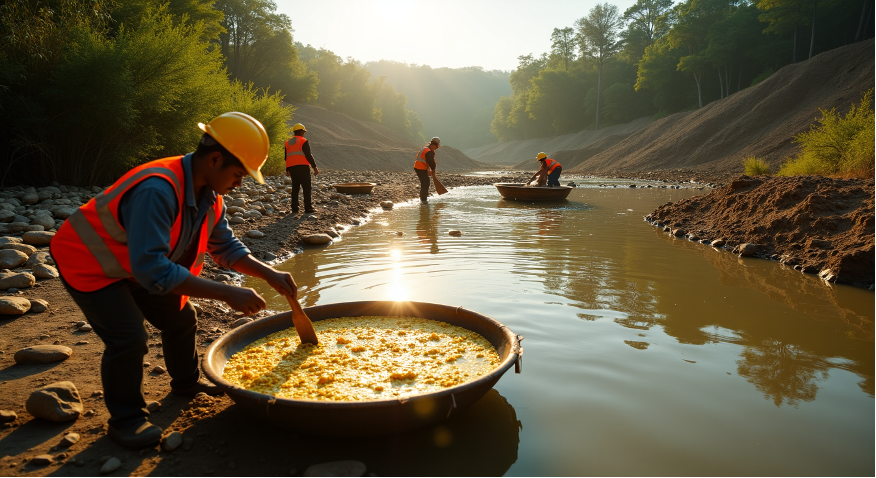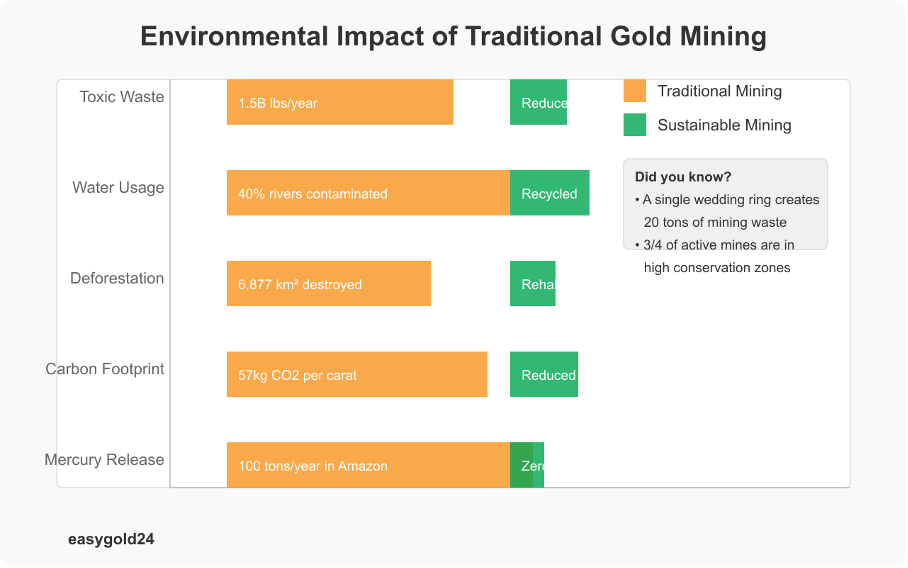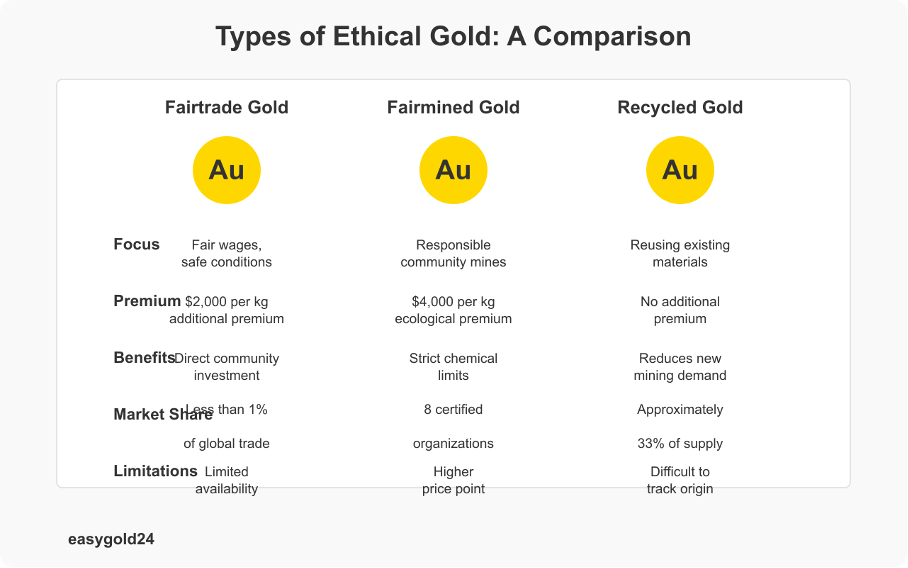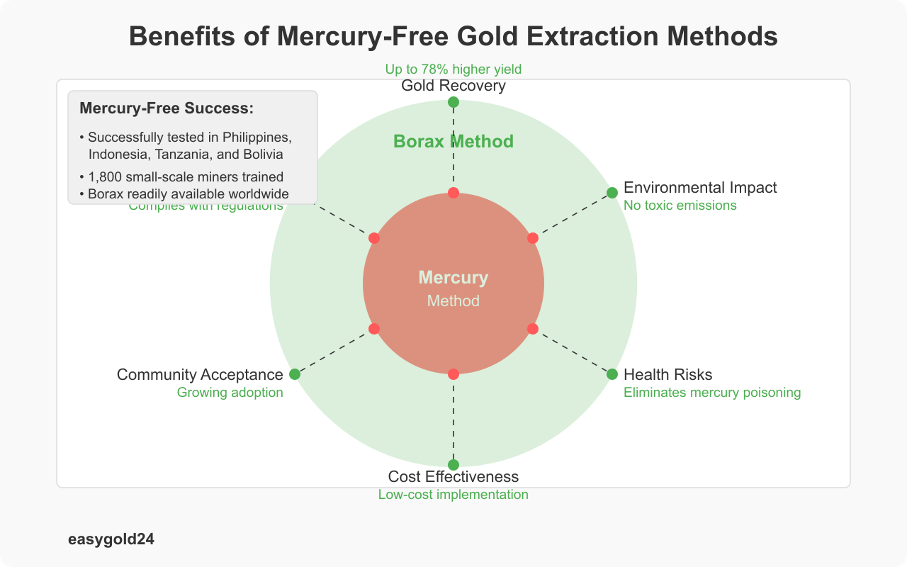SUSTAINABLE GOLD
Why Sustainable Gold Jewelry Matters: The Environmental & Ethical Truth About Responsible Sourcing

The global gold market required 3,760 tons of gold as of 2020. Yet only 1% of traded gold comes from proven eco-friendly sources. These statistics demonstrate the urgent need for sustainable gold jewelry in today’s market.
Traditional gold mining ranks among the most destructive industries worldwide. A single mined carat releases 57 kg of carbon into our atmosphere. Mining activities discharge approximately 100 tons of toxic mercury into the Amazon each year. Unethical practices continue to affect over 100 million people in the jewelry industry, many of whom work in dangerous conditions without proper regulations.
The importance of green jewelry and the role of conflict-free gold as a game-changer deserve our attention. This guide examines the environmental effects, human rights issues, and cost-effective solutions. These insights can guide conscious consumers toward better choices for our planet and its people.
The Real Cost of Traditional Gold Mining

Conventional gold mining ranks as one of the most environmentally harmful industries in the world. A single wedding ring creates 20 tons of mining waste. This fact merely hints at the true cost to our environment and society.
Environmental damage from mining
| Impact Area | Traditional Mining | Sustainable Mining |
|---|---|---|
| Water | Contaminates 40% of rivers and 50% of lakes | Uses advanced recycling systems |
| Chemicals | 200M lbs of arsenic, 4M lbs of mercury yearly | Mercury-free extraction methods |
| Land Use | High deforestation rates | Land rehabilitation practices |
| Energy | High carbon footprint | Renewable energy sources |
Metal mining tops the list of toxic polluters. It produces 1.5 billion pounds of chemical waste yearly and constitutes more than 40% of all reported toxic releases. Three out of four active mines are situated in areas designated as high conservation zones.
Impact on local communities
Local communities bear the brunt of mining operations. Indigenous peoples often lose their ancestral lands to these activities. Half of all gold mined from 1995 to 2015 came from indigenous territories. The lives of 50 to 100 million people are disrupted by small-scale gold mining.
Mining creates sharp economic divides in these areas. While it brings some economic benefits, wealthy power brokers capture most of the profits. Poor local communities end up dealing with the environmental fallout. They rarely receive their fair share of educational and lifestyle improvements that should accompany natural resource extraction.
Health risks to miners
Mining stands among the deadliest professions worldwide. Miners comprise just 1% of global workers but account for 5% of all workplace deaths. Underground miners face numerous health challenges:
- Shorter life spans
- Higher cancer rates in the trachea, bronchus, lung, stomach, and liver
- More cases of pulmonary tuberculosis and silicosis
- Greater risk of insect-borne diseases
- Hearing loss from noise exposure
Deep shaft mining conditions push temperatures to 60 degrees Celsius (140 degrees F). This heat damages miners’ nervous systems and raises their blood pressure. Miners who work with mercury risk severe contamination. The mercury levels in their air, food, hair, urine, and blood exceed all safety limits.
Mining’s health effects extend beyond the workers. People living near mines often consume contaminated water. This contamination causes birth defects, malnutrition, and various disorders from toxic exposure.
Problems in Traditional Mining
The devastating effects of dirty gold mining extend far beyond environmental damage. These effects include toxic chemical usage and human exploitation. Let us examine these critical issues that make environmentally responsible practices essential.
Mercury and cyanide use
Mercury continues to threaten gold mining operations. Miners often mix it with gold-bearing soil using their bare hands. This dangerous practice affects approximately 33% of artisanal miners who suffer from moderate metallic mercury vapor intoxication. Mercury contamination persists in groundwater for years and creates long-term health hazards for communities near mining sites.
Cyanide, another toxic chemical used in gold extraction, presents equally serious risks. Industry claims about its safety fail when we examine major environmental disasters from cyanide spills. For example, a single accident in Romania contaminated water supplies up to 250 miles downstream. The compounds remain harmful even after cyanide breaks down, especially in groundwater where they can persist indefinitely.
Deforestation impact
Mining operations have become one of the main drivers of deforestation worldwide. Gold and coal mining destroyed 6,877 square kilometers of forest in the last two decades. These operations require vast areas cleared for:
- Excavation pits
- Access roads
- Workers’ settlements
- Processing facilities
- Storage infrastructure
Worker exploitation
Unregulated mining practices take a severe human toll. Children work in hazardous conditions, carrying heavy loads and handling toxic substances without protection. Workers face numerous health risks, such as:
- Respiratory diseases from dust exposure
- Neurological damage from mercury exposure
- Physical injuries from unsafe working conditions
- Long-term disability from toxic chemical exposure
What makes gold sustainable
Low-impact gold mining prioritizes responsible practices to protect workers and the environment. Modern approaches like in-situ leaching and bio-mining reduce surface destruction and waste generation. These methods use:
- Clean energy sources (solar, wind, hydroelectric)
- Advanced water recycling systems
- Waste reduction techniques
- Digital technologies for resource efficiency
Different types of ethical gold
The marketplace now offers three main categories of responsibly sourced gold:
| Type | Focus | Benefits | Limitations |
|---|---|---|---|
| Fairtrade Gold | Fair wages, safe conditions | Direct community investment | Limited availability |
| Fairmined Gold | Responsible community mines | Strict chemical limits | Strict chemical limits Higher price point |
| Recycled Gold | Reusing existing materials | Reduces new mining demand | Difficult to track origin |
Certified ethical mines must meet specific standards for:
- Environmental protection
- Drinking water preservation
- Safe chemical handling procedures
- Gender equality
- Prevention of child labor
Understanding Sustainable Gold

The gold mining industry is undergoing a major transformation in metal sourcing and processing methods. Recent data shows certified eco-friendly gold constitutes only 1% of global gold trade. This small percentage reveals both challenges and opportunities for ethical jewelry makers.
Small-batch gold jewelry adheres to strict standards to protect the environment and benefit communities. The Responsible Gold Mining Principles (RGMPs) establish clear expectations for buyers, investors, and the entire gold supply chain. These guidelines combine existing standards into one framework that addresses environmental, social, and governance issues in gold mining.
Two main certifications verify green gold production:
- Fairtrade Gold: Ensures fair wages and safe working conditions for miners
- Fairmined Certification: Verifies gold from responsible artisanal and small-scale mining organizations that meet world-leading standards
Three essential elements define eco-friendly gold mining. Responsible sourcing comes from suppliers with high social, environmental, and human rights standards. Mining operations protect biodiversity through careful land management and restoration. The process includes advanced water management systems that reduce pollution and conserve water resources.
Technology has revolutionized eco-friendly mining practices. Companies now utilize renewable energy to reduce their carbon footprint. Some operations have transitioned to natural extraction methods like bioleaching and phytomining instead of harmful chemicals.
Clear communication remains crucial for eco-friendly gold production. Companies following RGMPs require verification from independent third-party providers. This process examines both sites and corporate offices to ensure they adhere to established standards.
Eco-friendly gold mining offers more than environmental advantages. The higher initial costs lead to better long-term economic stability. Local communities benefit through:
- Education initiatives
- Infrastructure development
- Job creation opportunities
- Cultural heritage preservation
The World Gold Council and major mining companies continue to improve these standards. They work to create trusted guidelines that align gold production with responsible practices. This dedication demonstrates how mineral wealth can benefit current and future generations while protecting nature and promoting social justice.
Problems in Traditional Mining
The devastating effects of dirty gold mining extend far beyond environmental damage. These effects include toxic chemical usage and human exploitation. Let us examine these critical issues that make environmentally responsible practices essential.
Mercury and cyanide use
Mercury continues to threaten gold mining operations. Miners often mix it with gold-bearing soil using their bare hands. This dangerous practice affects approximately 33% of artisanal miners who suffer from moderate metallic mercury vapor intoxication. Mercury contamination persists in groundwater for years and creates long-term health hazards for communities near mining sites.
Cyanide, another toxic chemical used in gold extraction, presents equally serious risks. Industry claims about its safety fail when we examine major environmental disasters from cyanide spills. For example, a single accident in Romania contaminated water supplies up to 250 miles downstream. The compounds remain harmful even after cyanide breaks down, especially in groundwater where they can persist indefinitely.
Deforestation impact
Mining operations have become one of the main drivers of deforestation worldwide. Gold and coal mining destroyed 6,877 square kilometers of forest in the last two decades. These operations require vast areas cleared for:
- Excavation pits
- Access roads
- Workers’ settlements
- Processing facilities
- Storage infrastructure
Worker exploitation
Unregulated mining practices take a severe human toll. Children work in hazardous conditions, carrying heavy loads and handling toxic substances without protection. Workers face numerous health risks, such as:
- Respiratory diseases from dust exposure
- Neurological damage from mercury exposure
- Physical injuries from unsafe working conditions
- Long-term disability from toxic chemical exposure
Key Players in Ethical Gold Mining
The jewelry industry’s ethical gold mining landscape is shaped by numerous organizations and certifying bodies working toward a more sustainable future.
Certified mining organizations
FLOCERT conducts independent auditing for Fairtrade gold certification and holds the prestigious ISO 17065 accreditation. The organization’s thorough verification process provides mines and businesses with clear standards to meet Fairtrade requirements. They verify everything from transaction traceability to financial transparency.
Since 2004, the Alliance for Responsible Mining (ARM) has supported over 150 mining groups in Latin America and Africa. Their certified mining organizations have received $1,530,000 in Fairmined Premium payments that directly fund community development projects.
Small-scale artisanal miners
Small-scale artisanal mining (ASM) is a vital sector that produces 12-15% of the world’s gold. The sector employs 10-15 million miners, of whom 4-5 million are women and children. These miners receive substantial support through several programs:
- A guaranteed minimum price at 95% of the London Bullion Market Association’s price
- Premium payments of $2,000 per kilogram for certified Fairtrade gold
- Authority to decide how premium investments are used
- Access to technical assistance and skill-building programs
Leading sustainable jewelry brands
More jewelry brands now embrace conflict-free sourcing practices. Here’s how top sustainable brands stand apart:
| Brand | Sustainable Practices | Materials Used |
|---|---|---|
| AUrate | Process transparency | 100% recycled gold, conflict-free diamonds |
| Mejuri | Supply chain tracking | 70% recycled gold, 30% RJC-certified |
| Emily Chelsea | Zero-waste programs | Only recycled or Fairmined gold |
| Brilliant Earth | Community support | 93% recycled precious metals |
The Federal Reserve’s policy changes have created an ideal environment for gold investment. Analysts predict approximately 100 basis points in rate cuts throughout 2025, which could enhance gold’s attractiveness as an investment option.
These innovative brands implement sustainable practices such as:
- Supporting local communities where they produce their pieces
- Providing full supply chain tracking
- Operating zero-waste programs
- Using ethically sourced gemstones
Sustainable practices continue to gain momentum. Eight mining organizations now hold Fairmined Certification. They focus on reducing environmental impacts through mercury-free extraction methods. These certified operations demonstrate that responsible gold mining can protect the environment and foster community development.
Benefits of Choosing Sustainable Gold
- Sustainable gold creates positive changes that ripple through ecosystems and communities worldwide. These changes extend far beyond the jewelry itself and promote environmental protection and social advancement.
Environmental preservation
Modern sustainable mining methods substantially reduce ecological damage. Mercury-free extraction safeguards water resources and soil quality. Miners can now achieve high gold recovery rates without toxic chemicals, which protects their health and surrounding ecosystems.
Sustainable operations implement state-of-the-art water management strategies. Advances in filtration and desalination help mines recycle water more effectively and reduce freshwater consumption. Mining complexes that achieve zero waste discharge preserve local water bodies.
Land rehabilitation forms the foundation of sustainable mining practices. Operations carefully preserve nutrient-rich topsoil and store it separately before extraction begins. This preserved soil helps restore mining sites later and enables native plants to regenerate naturally.
Community development
Sustainable gold mining creates lasting positive socio-economic changes in communities. Workers at certified Fairtrade mines earn approximately 99% of spot value for their gold—roughly 25% more than traditional operations. Mining communities also receive an additional USD 200,000 premium for each kilogram of gold.
Communities benefit directly through:
- Healthcare facilities
- Educational programs
- Infrastructure development
- Cultural heritage preservation
Fair labor practices and gender equality remain top priorities in sustainable mining operations. For instance, 4.5 million women now work in artisanal and small-scale gold mining. Economic spillover effects help support approximately 80 million people in rural communities.
Mining revenues fund critical development projects that strengthen local governance. Sustainable operations provide youth with alternatives to criminal groups in fragile regions, which helps maintain community stability.
Digital technologies and automation help mines optimize resource efficiency. These innovations enable precise data collection and analysis, leading to environmentally conscious operations that benefit both the planet and its inhabitants.
How to Shop for Sustainable Gold Jewelry
When purchasing ethical gold jewelry, consider these questions:
- What certifications does the piece carry? (Fairtrade, Fairmined, RJC)
- Can the brand provide the gold’s origin information?
- What percentage is recycled versus newly mined?
- How transparent is the company about its supply chain?
- What environmental initiatives does the company support?
Sustainable Mining Solutions

New technologies are revolutionizing gold mining with solutions that protect the environment and communities. EnviroMetal Technologies leads this transformation with groundbreaking extraction methods that eliminate toxic emissions and wastewater.
Mercury-free extraction methods
The borax method represents a significant improvement over traditional extraction techniques. It produces 78% more gold than conventional amalgamation processes. Small-scale miners in the Philippines, Indonesia, Tanzania, Bolivia, and Zimbabwe now successfully implement this method.
The process involves:
- Gravitational concentration of heavy minerals
- Addition of borax to reduce melting points
- Smelting with basic equipment
This method proves effective because miners don’t require expensive equipment upgrades. Danish-funded training programs have helped 1,800 small-scale miners transition to borax-based extraction.
Land restoration practices
Pure Earth drives remarkable restoration efforts in mining-affected regions. They have restored 10 hectares of Amazon rainforest damaged by mining. Their careful planning achieved a 71% survival rate for 13,750 seedlings from 19 different species.
The restoration process includes several key elements:
- Biochar application to stabilize mercury in soil
- Strategic use of native vegetation
- Development of artificial wetlands to purify water
Miners participate in these restoration efforts and acquire valuable skills such as:
- Creating soil amendments
- Applying nutrients to depleted soil
- Caring for planted saplings
The rehabilitation focuses on rebuilding landscapes that match surrounding undisturbed areas. This approach facilitates the return of natural processes and accelerates site recovery through:
- Surface reshaping
- Drainage system restoration
- Waste rock pile stabilization
- Stream channel reconstruction
These low-impact solutions demonstrate how modern mining can coexist with environmental preservation. Mercury-free extraction methods combined with comprehensive land restoration practices guide the industry toward a more sustainable future.
Responsible Gold. Real Impact.
Sustainable gold is no longer a niche. It reflects a growing global awareness of how precious metals are sourced—and the responsibility that comes with it. Fair wages, clean extraction methods, and the active restoration of mining environments are no longer optional. They are essential to future-proofing the gold industry.
Only a small share of the global gold trade meets these high standards. But that’s changing. Innovative companies and forward-looking investors are now driving demand for conflict-free and ethically sourced gold. Consumers are asking harder questions—and the answers matter.
At EasyGold, ethical sourcing is more than a promise. It is built into our long-term strategy. With the successful OTCQB listing of Hartmann & Benz shares, we are laying the foundation for a gold ecosystem that combines transparency, digital innovation, and direct participation in the physical gold market. Part of this evolution includes our security token—making large-scale gold ownership simpler, faster, and more secure.
Gold has always been a store of value. Now it can also be a force for change. Decide where your gold comes from—and what it stands for.
